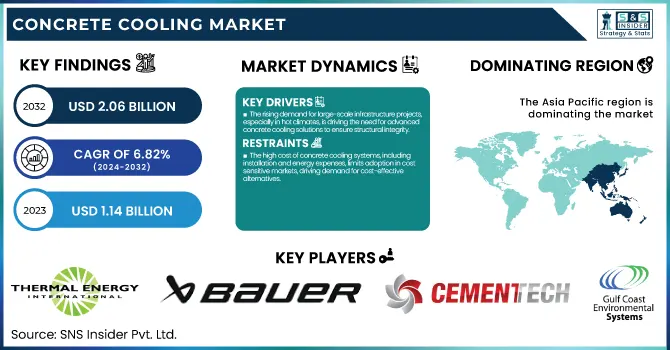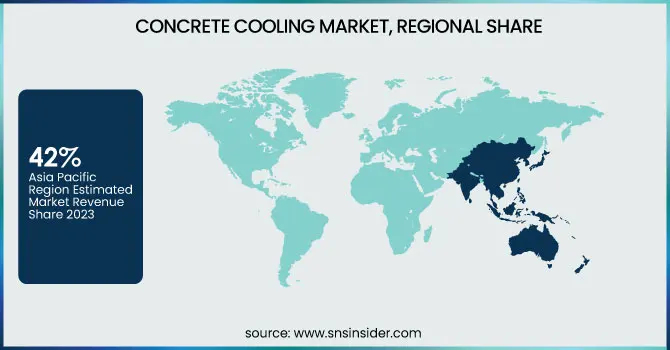Concrete Cooling Market Report Scope & Overview:
The Concrete Cooling Market Size was estimated at USD 1.14 billion in 2023 and is expected to arrive at USD 2.06 billion by 2032 with a growing CAGR of 6.82% over the forecast period 2024-2032.

To Get more information on Concrete Cooling Market - Request Free Sample Report
The report offers a unique perspective on the Concrete Cooling Market by analyzing adoption trends across key regions, highlighting the integration of cooling technologies in modern construction. It examines equipment utilization patterns, showcasing efficiency improvements and industry preferences. A deep dive into energy consumption & efficiency metrics uncovers sustainability advancements, while export/import data provides insights into global trade flows. Additionally, the report covers emerging trends such as AI-driven temperature monitoring, eco-friendly cooling solutions, and rising demand in mega infrastructure projects to offer a forward-looking industry outlook.
The U.S. concrete cooling market is experiencing steady growth, with a projected CAGR of 7.45% from 2023 to 2032. Market value is expected to rise from USD 0.20 billion in 2023 to USD 0.38 billion by 2032, surge in infrastructure projects, warming temperatures, and demand for high-performance concrete. In larger construction projects, advanced cooling techniques like chilled water systems and liquid nitrogen cooling are gaining traction. Market growth is further propelled by government investments in sustainable infrastructure as well as increasing commercial and industrial projects. Urbanization trend and strict quality standards are still reshaping market dynamics.
Concrete Cooling Market Dynamics
Drivers
-
The rising demand for large-scale infrastructure projects, especially in hot climates, is driving the need for advanced concrete cooling solutions to ensure structural integrity.
The growing construction industry is a key driver of the concrete cooling market, fueled by the increasing demand for large-scale infrastructure projects such as highways, bridges, dams, and skyscrapers. It becomes essential to maintain the temperature of concrete in hot climate areas so that early hydration does not take place. Demand for cooling in city infrastructures is steadily increasing, with governments and private entities putting major thought into urbanization and smart cities, and innovative cooling solutions such as ice-based cooling, liquid nitrogen cooling, and chilled water systems are becoming more and more prevalent. Besides, several trends like focus on sustainable construction and energy-efficient cooling technologies are affecting the market, while innovations in solar-powered and hybrid cooling systems are moving forward. The skilled progress in the Farrago is expected due to criteria-offering countries such as India, China, and the Middle East, it is substantiated that the rapid increase in the Farrago tropics, coupled with extreme temperature threats around the world and the increased need for high-renowned basis construction, incline to bring progress to the market.
Restraint
-
The high cost of concrete cooling systems, including installation and energy expenses, limits adoption in cost-sensitive markets, driving demand for cost-effective alternatives.
The high initial investment and operating costs of concrete cooling systems, such as ice plants, liquid nitrogen cooling, and water chillers, present a significant challenge to market growth. These technologies require substantial up-front installation costs, as well as ongoing maintenance and energy expenses, putting them out of reach for small- and mid-sized construction firms. To save costs, contractors, especially in sensitive markets, tend to invest in traditional means of cooling, which are less efficient, rather than face the high cost of adoption upfront. Moreover, increasing fuel and electricity prices add to the operating cost, restricting mass-market penetration. But the field is also moving in the direction of more energy-efficient, cost-effective solutions, like hybrid cooling systems and phase change materials (PCMs), that can lower costs over the long term. With sustainability and energy efficiency becoming increasingly important in construction, manufacturers are focused on developing innovative solutions to the affordability and accessibility of concrete cooling and gradually breaking down the cost barrier in the market.
Opportunities
-
The demand for sustainable construction is driving the adoption of energy-efficient, eco-friendly concrete cooling solutions, integrating smart technologies and low-carbon alternatives.
The rising demand for sustainable construction is driving the adoption of eco-friendly concrete cooling solutions. With governments and regulatory authorities implementing stricter environmental regulations, construction firms are gradually moving towards green building materials and energy-efficient measures. Conventional cooling strategies, including systems that use ice, are power-hungry, prompting industry to seek out alternatives, including liquid nitrogen cooling, phase-change materials, and solar-powered systems. There are also other tech, such as smart cooling, that automates temperature monitoring and AI-driven optimization. The increasing focus on minimizing carbon footprints in large infrastructure initiatives further drives the adoption of sustainable concrete cooling approaches. As the construction sector continues to grow in hotter climate zones, especially in the Middle East, Asia-Pacific, and Africa, there are forecasts for increased demand for energy-efficient cooling solutions. These trends influence the market, and the manufacturers are trying to develop cost-effective, eco-friendly, and technologically advanced concrete cooling solutions to address the changing industry needs.
Challenges
-
Economic slowdowns reduce construction activities, lowering the demand for concrete cooling solutions due to delayed projects and budget constraints.
Economic slowdowns significantly impact the demand for concrete cooling solutions as construction activities decline due to reduced investments and budget constraints. During periods of economic instability, governments and private sector players tend to postpone or cancel infrastructure and real estate projects, which results in a decline in the demand for temperature-controlled concrete. This directly influences the market of cooling solutions like ice plants, liquid nitrogen cooling, and water-cooling systems. Moreover, interest rate spikes and inflation put upward pressure on project costs, leading developers to shy away from innovative cooling technologies. But despite these challenges, the market is seeing trends like the adoption of energy-efficient and sustainable cooling techniques to comply with green building initiatives. Long-term, smart infrastructure projects, urbanization, and the expansion of construction in hot climate regions should drive growth. During an economic downturn, there could be companies with innovative, cost-effective, and eco-friendly cooling solutions.
Concrete Cooling Market Segmentation Analysis
By Type
The Ice Cooling segment dominated with a market share of over 42% in 2023, owing to its higher efficiency in lowering the temperature of concrete as compared to other methods, making it a perfect choice for large infrastructure projects and locations with high ambient temperatures. Flake or crushed ice is incorporated directly into the concrete mixture, helping to manage the heat of hydration and preventing cracks that can occur due to thermal expansion. Ice cooling is extensively used in dam construction, bridges, and energy-saving concrete construction in high-rise buildings. Its widespread adoption in hot climates, reliability, and cost-effectiveness played a huge role in making it a market leader. This still maintains concrete's dominance in the sector owing to the increasing urbanization and development of infrastructure.
By Application
The highway construction segment dominated with a market share of over 38% in 2023, accounting for a significant market share. There is a growing need for sound concrete cooling solutions due to the rising demand for long-lasting and high-quality roads, specifically in areas that are quickly urbanizing and expanding their infrastructure. Thermal cracking is a common problem on highways, so the structural integrity of highways is supported by proper cooling techniques. This has prompted the allocation of a significant portion of the ongoing government and private sector-associated budgets to highway development projects, propelling the market growth. Moreover, efficient construction is enabled by enhanced cooling technologies like water cooling and Cryogenic cooling. This ensures highway construction continues to be the most dominant segment in terms of segmental growth of the concrete cooling market.
Concrete Cooling Market Regional Outlook
The Asia-Pacific region dominated with a market share of over 42% in 2023, due to rapid urbanization, large-scale infrastructure projects, and increasing construction activities across key countries such as China, India, and Southeast Asian nations. The growing demand for durable and high-strength concrete in megaprojects, highways, bridges, and commercial buildings has fueled the adoption of advanced cooling solutions. Additionally, the region experiences extreme climatic conditions, making concrete cooling essential to prevent cracking and maintain structural integrity. Government initiatives promoting smart cities and industrial expansion further drive market growth. The presence of major construction companies and suppliers offering innovative cooling technologies has strengthened the region's dominance. With continued investments in real estate and infrastructure, Asia-Pacific is expected to sustain its leadership in the concrete cooling industry.
North America is the fastest-growing region in the Concrete Cooling Market, due to its scale infrastructure and commercial projects with temperature-controlled concrete applications. The U.S. and Canada are booming, which requires effective cooling solutions to maintain the strength and durability of the concrete. Growing investments in transportation, residential, and industrial construction also drive market growth. Some new cooling methods, like liquid nitrogen cooling and ice-based cooling systems, have also been developed to be more efficient and cost-effective. In addition, strict regulatory standards governing concrete quality and sustainability are encouraging greater use of advanced cooling solutions. As populations continue to urbanize and infrastructure continues to modernize, North America is set to experience significant progress in the concrete cooling market.

Get Customized Report as per Your Business Requirement - Enquiry Now
Key Players
-
Kryotech (Liquid Nitrogen Cooling Systems)
-
Thermal Energy International (Industrial Cooling Solutions)
-
Bauer (Chillers & Water-Cooling Systems)
-
Gulf Coast Environmental Systems (Water Chillers & Ice Plants)
-
Cementech (Volumetric Mixers with Cooling Features)
-
Sika (Concrete Admixtures & Cooling Agents)
-
Celsius (Thermal Management Solutions)
-
Cryogenics (Cryogenic Cooling Systems)
-
Kawasaki (Industrial Refrigeration Systems)
-
Air Products and Chemicals (Liquid Nitrogen for Concrete Cooling)
-
Coldcrete Inc. (Chilled Water & Ice-Based Cooling Systems)
-
LINTEC & LINNHOFF (Concrete Batching & Cooling Solutions)
-
North Star Ice Equipment (Ice Generation Systems)
-
Recom Ice Systems (Flake Ice & Water Chillers)
-
Kirloskar Pneumatic (Industrial Cooling Solutions)
-
Fujian Snowman Co., Ltd. (Flake Ice Machines)
-
Trane Technologies (Industrial Chillers)
-
Daikin Industries (Cooling & Refrigeration Solutions)
-
Carrier Global Corporation (Industrial Chillers & Cooling Systems)
-
KTI-Plersch Kältetechnik GmbH (Concrete Cooling Plants)
Suppliers for (Advanced liquid nitrogen cooling solutions for concrete) on the Concrete Cooling Market
-
NITROcrete
-
Coldcrete Inc.
-
Singhsons Refrigeration
-
North Star Ice Equipment
-
Termodizayn
-
Alperen Mühendislik
-
KTI-Plersch Kältetechnik GmbH
-
Recom Ice Systems
-
Focusun Refrigeration Corporation
-
Iceman Technologies
Recent Development
-
In July 2024, Trane expanded its data centre solutions, focusing on larger-scale infrastructure and bespoke cooling technologies to meet growing demand for high-density, energy-efficient, and sustainable cooling systems. Their expertise in HVAC and service infrastructure continues to drive innovation in the sector.
| Report Attributes | Details |
|---|---|
| Market Size in 2023 | USD 1.14 Billion |
| Market Size by 2032 | USD 2.06 Billion |
| CAGR | CAGR of 6.82% From 2024 to 2032 |
| Base Year | 2023 |
| Forecast Period | 2024-2032 |
| Historical Data | 2020-2022 |
| Report Scope & Coverage | Market Size, Segments Analysis, Competitive Landscape, Regional Analysis, DROC & SWOT Analysis, Forecast Outlook |
| Key Segments | •By Type (Water Cooling, Ice Cooling, Air Cooling, Liquid Nitrogen Cooling) •By Application (Highway Construction, Dams & Locks, Port Construction, Nuclear Plant Construction) |
| Regional Analysis/Coverage | North America (US, Canada, Mexico), Europe (Eastern Europe [Poland, Romania, Hungary, Turkey, Rest of Eastern Europe] Western Europe] Germany, France, UK, Italy, Spain, Netherlands, Switzerland, Austria, Rest of Western Europe]), Asia Pacific (China, India, Japan, South Korea, Vietnam, Singapore, Australia, Rest of Asia Pacific), Middle East & Africa (Middle East [UAE, Egypt, Saudi Arabia, Qatar, Rest of Middle East], Africa [Nigeria, South Africa, Rest of Africa], Latin America (Brazil, Argentina, Colombia, Rest of Latin America) |
| Company Profiles | Kryotech, Thermal Energy International, Bauer, Gulf Coast Environmental Systems, Cementech, Sika, Celsius, Cryogenics, Kawasaki, Air Products and Chemicals, Coldcrete Inc., LINTEC & LINNHOFF, North Star Ice Equipment, Recom Ice Systems, Kirloskar Pneumatic, Fujian Snowman Co., Ltd., Trane Technologies, Daikin Industries, Carrier Global Corporation, KTI-Plersch Kältetechnik GmbH. |

